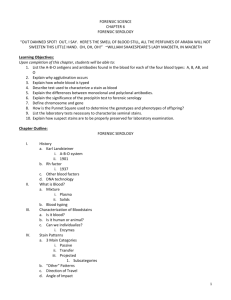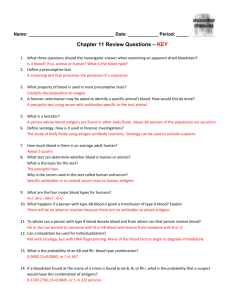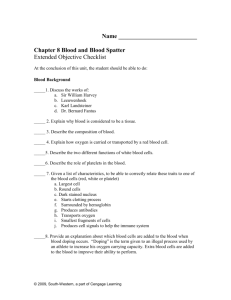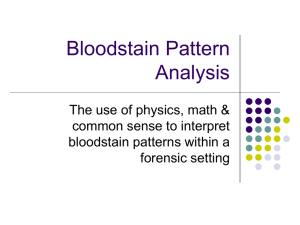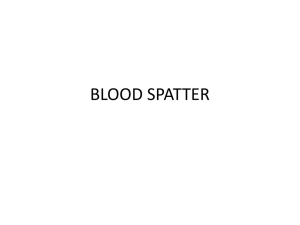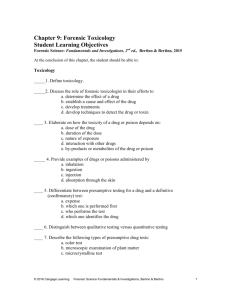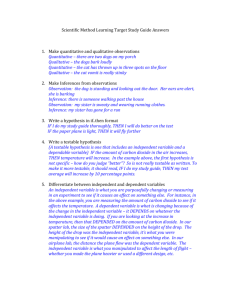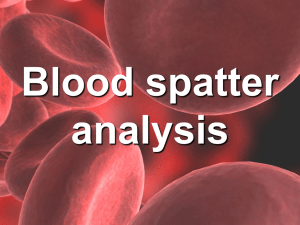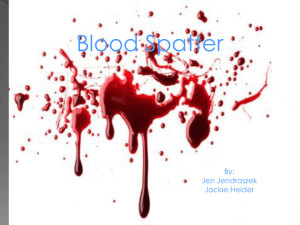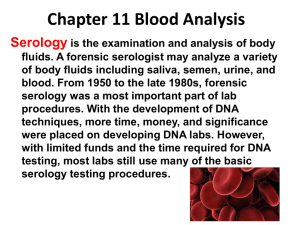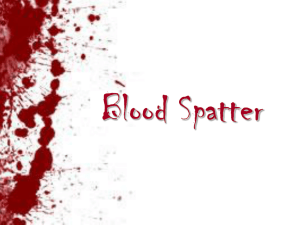Objective Sheet Blood Splatter
advertisement
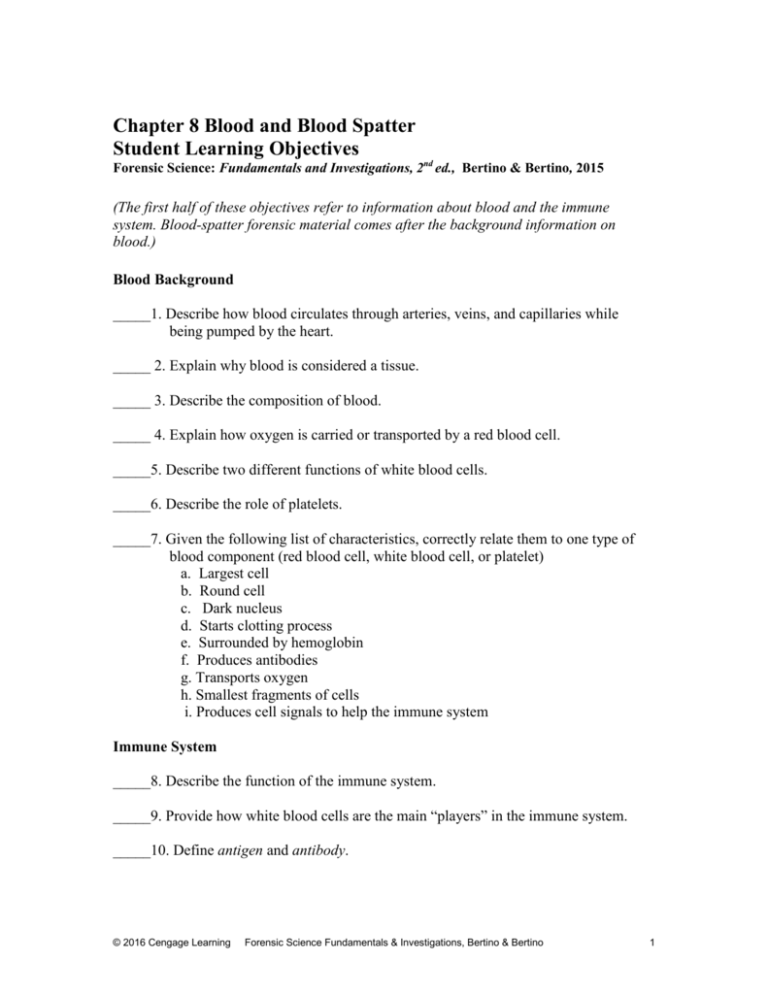
Chapter 8 Blood and Blood Spatter Student Learning Objectives Forensic Science: Fundamentals and Investigations, 2nd ed., Bertino & Bertino, 2015 (The first half of these objectives refer to information about blood and the immune system. Blood-spatter forensic material comes after the background information on blood.) Blood Background _____1. Describe how blood circulates through arteries, veins, and capillaries while being pumped by the heart. _____ 2. Explain why blood is considered a tissue. _____ 3. Describe the composition of blood. _____ 4. Explain how oxygen is carried or transported by a red blood cell. _____5. Describe two different functions of white blood cells. _____6. Describe the role of platelets. _____7. Given the following list of characteristics, correctly relate them to one type of blood component (red blood cell, white blood cell, or platelet) a. Largest cell b. Round cell c. Dark nucleus d. Starts clotting process e. Surrounded by hemoglobin f. Produces antibodies g. Transports oxygen h. Smallest fragments of cells i. Produces cell signals to help the immune system Immune System _____8. Describe the function of the immune system. _____9. Provide how white blood cells are the main “players” in the immune system. _____10. Define antigen and antibody. © 2016 Cengage Learning Forensic Science Fundamentals & Investigations, Bertino & Bertino 1 _____ 11. List characteristics of antibodies: a. What cells produce antibodies? b. When are antibodies produced? c. Will any antibody work on any antigen? Why or why not? d. Sketch an antibody. f. Label the part of the antibody that is specific to an antigen. g. Besides having been sick with a virus or bacteria, how else could someone acquire antibodies? _____ 12. Compare and contrast antigens and antibodies. _____ 13. Describe an antigen-antibody reaction, and explain how an antibody identifies an antigen. _____ 14. Describe the effect of antibodies on an antigen. Blood Types _____ 15. List three different antigens found on red blood cells. _____ 16. Distinguish between the following blood types: a. b. c. d. e. f. g. A+ BAB+ O+ OAB+ _____ 17.Sketch a red blood cell from someone who has each of the following blood types a. A+ b. B- c. AB+ d. O_____ 18. Describe how to determine someone’s blood type. _____ 19. Analyze the results of blood typing to determine someone’s blood type. _____ 20. Explain why blood types provide class evidence and not individual evidence. ____ 21. Explain why does giving someone the wrong blood type results in an antigenantibody reaction? Include in your answer the definition of the term agglutination. © 2016 Cengage Learning Forensic Science Fundamentals & Investigations, Bertino & Bertino 2 _____ 22. Given the individual probabilities of having different antigens in the blood, be able to calculate the probability of someone having a specific blood type consisting of several different blood antigens. Blood Spatter _____ 23. Distinguish between spines and satellites in blood spatter. _____ 24. Devise an experiment to determine the effect on the blood spatter of blood being dropped: a. From different heights b. Onto different surfaces c. From different angles _____ 25. Distinguish between the terms cohesion and adhesion. _____ 26. Using the terms cohesion and gravity, explain why a drop of blood will be circular in appearance as it drops. _____ 27. Using the terms cohesion and surface tension, explain why blood will appear as a rounded surface when it lands on flat surface. _____ 28. Using the terms momentum and cohesion, explain why most of the blood will remain as a drop where it first strikes a surface, but some of the blood will continue to move forward, forming an elongated "spine." _____ 29. Given a number of blood-spatter stains; be able to determine the direction that the blood was moving. Include in your answer the shape of the blood spatter and the terms satellite and blood spatter.. _____30. Distinguish between the following bloodstain patterns: a. Cast off b. Transfer c. Shadowing, or void _____ 31. Distinguish between a swipe and a wipe bloodstain pattern. _____ 32. Describe the forensic significance of identifying the type of blood spatter found at a crime scene. ____33.Explain the blood spatter pattern called an arterial gush. Include in your answer the following: a. The overall pattern of the blood spray b. The reason the pattern shows high points and low points. © 2016 Cengage Learning Forensic Science Fundamentals & Investigations, Bertino & Bertino 3 ____ 34.Describe the difference in a blood spatter pattern if blood was dropped from a height of 30 cm vs. 100 cm. ____ 35.Define the term terminal velocity. ____ 36. Explain the relationship of terminal velocity to the size of a droplet of blood as it is dropped from different heights ranging from 50 cm to 100 cm to 300 cm. _____ 37. Given two blood spatter patterns, to be able to distinguish a difference between high-velocity blood spatter size(gunshot wound) versus low-velocity blood spatter size (blunt-force trauma). _____38.Given two blood spatter patterns, to be able to determine which came from a gun fired at close range and which came from a gun fired from a distance. _____ 39. Draw lines of convergence lines to determine the source of blood. _____ 40. Distinguish between lines of convergence and area of convergence. ______41. Explain how to draw lines of convergence from several drops of blood in order to determine the area of convergence or source of blood. Include in your answer: a. How to determine the direction or movement of the blood b. Where to begin drawing your line in reference to the main blood droplet and the satellite blood drops. c. How should the line be drawn through the main droplet of bloodstain? d. How far to draw your lines e. How to determine the area of convergence using these lines of convergence. f. How to draw a circle around the area of convergence. _____ 42. Define angle of impact for blood spatter. a. How is angle of impact used in forensic blood spatter analysis? b. How does the angle of impact affect the shape of blood spatter? _____ 43. Describe how to recognize if a blood drop was dropped straight down (90 degree drop) based upon the shape of the drop at impact. _____ 44. Explain what happens to the shape of a blood spatter as you move from a 10degree impact angle to a 60-degree impact angle. _____ 45. Explain how to calculate the impact angle from a single droplet of blood. _____ 46. Differentiate between the area of convergence and the area of origin of blood. © 2016 Cengage Learning Forensic Science Fundamentals & Investigations, Bertino & Bertino 4 _____ 47. Given several drops of blood, determine the area of origin by a. Finding the area of convergence b. Calculating the impact angle of a single drop of blood c. Estimating the location of the area of origin by using a protractor and string and finding the area of convergence and measurement of the impact angle ____ 48. Estimate the area of origin using the tangent method. a. Find the area of convergence. b. Calculate the impact angle from a single drop of blood. c. Measure the distance from the leading edge of blood to the center of the area of convergence. d. Applying the law of tangents to estimate the area of origin. _____ 49. Given several drops of blood, to be able to analyze the crime scene by conducting a blood-spatter analysis: a. Determine the direction of motion of the blood. b. Determine the area of convergence of the blood droplets. c. Determine angle of impact for several drops of blood. d. Calculate the area of origin for the blood droplets using the protractor method or by applying the law of tangents. _____ 50. Use blood-spatter analysis to try to recreate the events of the crime. _____ 51. Determine if an eyewitness's account of what happened at the crime scene is consistent with the blood-spatter evidence. Chemical Testing of Blood Spatter _____ 52. Describe different tests used to screen for the presence of blood. _____ 53. Describe how Luminol can help to reveal blood spatter. Include in your answer: a. What is Luminol? b. How is it applied? c. What part of the blood reacts with Luminol? d. What type of light is needed to view evidence based upon Luminol? _____54. Describe antibody testing done to determine if blood is from a human or non-human source. © 2016 Cengage Learning Forensic Science Fundamentals & Investigations, Bertino & Bertino 5
